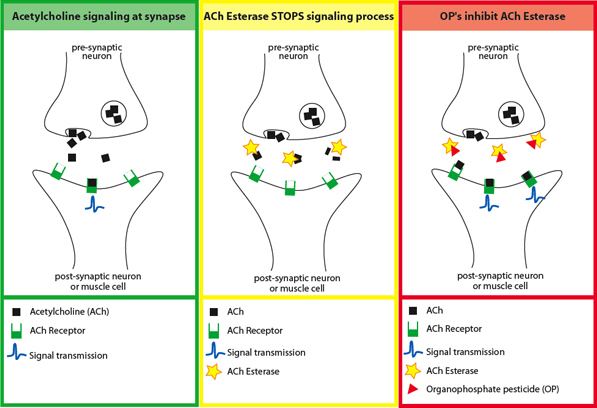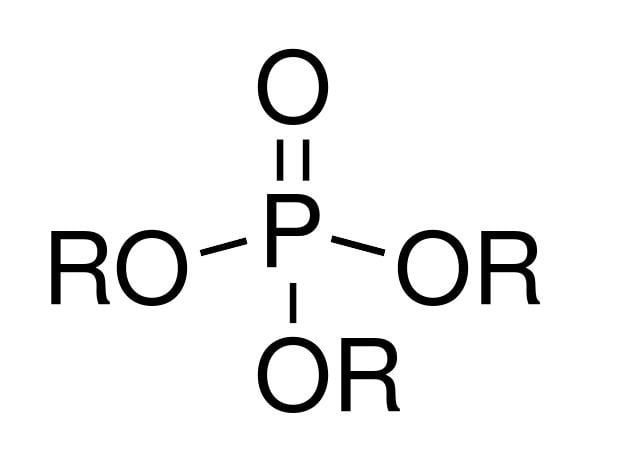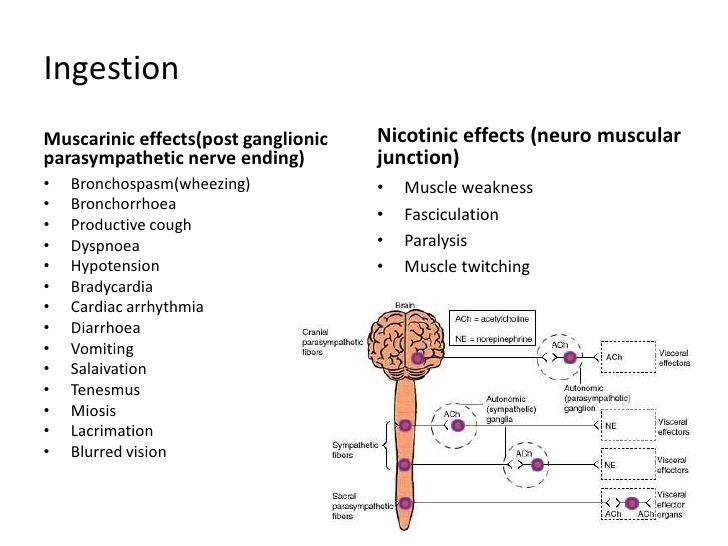Formula OP(OR)(OR')(OR") | ||
 | ||
8 organophosphate insecticide action
An organophosphate (sometimes abbreviated OP) or phosphate ester is the general name for esters of phosphoric acid. Many of the most important biochemicals are organophosphates, including DNA and RNA, as well as many of the cofactors essential for life. Organophosphates are the basis of many insecticides, herbicides, and nerve agents. The United States Environmental Protection Agency lists organophosphates as very highly acutely toxic to bees, wildlife, and humans. Recent studies suggest a possible link to adverse effects in the neurobehavioral development of fetuses and children, even at very low levels of exposure. Organophosphates are widely used as solvents, plasticizers, and EP additives.
Contents
- 8 organophosphate insecticide action
- Organophosphate toxicity
- Organophosphate pesticides
- History of nerve agents
- Structural features of organophosphates
- Terminal oxygen vs terminal sulfur
- Fine tuning
- Organophosphate poisoning
- Chronic toxicity
- Low level exposure
- Proposal restrictions
- References

Organophosphates are widely employed both in natural and synthetic applications because of the ease with which organic groups can be linked together.


The phosphate esters bearing OH groups are acidic and partially deprotonated in aqueous solution. For example, DNA and RNA are polymers of the type [PO2(OR)(OR')−]n. Polyphosphates also form esters; an important example of an ester of a polyphosphate is ATP, which is the monoester of triphosphoric acid (H5P3O10).

Alcohols can be detached from phosphate esters by hydrolysis, which is the reverse of the above reactions. For this reason, phosphate esters are common carriers of organic groups in biosynthesis.

Organophosphate toxicity
Organophosphate pesticides

In health, agriculture, and government, the word "organophosphates" refers to a group of insecticides or nerve agents acting on the enzyme acetylcholinesterase (the pesticide group carbamates also act on this enzyme, but through a different mechanism). The term is used often to describe virtually any organic phosphorus(V)-containing compound, especially when dealing with neurotoxic compounds. Many of the so-called organophosphates contain C-P bonds. For instance, Sarin is O-isopropyl methylphosphonofluoridate, which is formally derived from phosphorous acid (HP(O)(OH)2), not phosphoric acid (P(O)(OH)3). Also, many compounds which are derivatives of phosphinic acid are used as neurotoxic organophosphates.
Organophosphate pesticides (as well as sarin and VX nerve agent) irreversibly inactivate acetylcholinesterase, which is essential to nerve function in insects, humans, and many other animals. Organophosphate pesticides affect this enzyme in varied ways, and thus in their potential for poisoning. For instance, parathion, one of the first OPs commercialized, is many times more potent than malathion, an insecticide used in combatting the Mediterranean fruit fly (Med-fly) and West Nile Virus-transmitting mosquitoes.
Organophosphate pesticides degrade rapidly by hydrolysis on exposure to sunlight, air, and soil, although small amounts can be detected in food and drinking water. Their ability to degrade made them an attractive alternative to the persistent organochloride pesticides, such as DDT, aldrin, and dieldrin. Although organophosphates degrade faster than the organochlorides, they have greater acute toxicity, posing risks to people who may be exposed to large amounts (see the Toxicity section below).
Commonly used organophosphates have included parathion, malathion, methyl parathion, chlorpyrifos, diazinon, dichlorvos, phosmet, fenitrothion, tetrachlorvinphos, azamethiphos, and azinphos-methyl. Malathion is widely used in agriculture, residential landscaping, public recreation areas, and in public health pest control programs such as mosquito eradication. In the US, it is the most commonly used organophosphate insecticide. Forty organophosphate pesticides are registered in the U.S., with at least 73 million pounds used in agricultural and residential settings.
They are of concern to both scientists and regulators because they work by irreversibly blocking an enzyme critical to nerve function in both insects and humans. Even at relatively low levels, organophosphates may be most hazardous to the brain development of fetuses and young children. The EPA banned most residential uses of organophosphates in 2001, but they are still sprayed agriculturally on fruits and vegetables. They are also used to control pests such as mosquitos in public spaces such as parks. They can be absorbed through the lungs or skin or by eating them on food.
Studies have shown that Organosphophate pesticides can lead to health problems such as increased risk of cancer and premature birth as well as cardiovascular and respiratory diseases, Mexican American farm workers are disproportionately exposed to this toxin and its health effects
History of nerve agents
Early pioneers in the field include Jean Louis Lassaigne (early 19th century) and Philippe de Clermont (1854). In 1932, German chemist Willy Lange and his graduate student, Gerde von Krueger, first described the cholinergic nervous system effects of organophosphates, noting a choking sensation and a dimming of vision after exposure. This discovery later inspired German chemist Gerhard Schrader at company IG Farben in the 1930s to experiment with these compounds as insecticides. Their potential use as chemical warfare agents soon became apparent, and the Nazi government put Schrader in charge of developing organophosphate (in the broader sense of the word) nerve gases. Schrader's laboratory discovered the G series of weapons, which included Sarin, Tabun, and Soman. The Nazis produced large quantities of these compounds, though did not use them during World War II. British scientists experimented with a cholinergic organophosphate of their own, called diisopropylfluorophosphate, during the war. The British later produced VX nerve agent, which was many times more potent than the G series, in the early 1950s, almost 20 years after the Germans had discovered the G series.
After World War II, American companies gained access to some information from Schrader's laboratory, and began synthesizing organophosphate pesticides in large quantities. Parathion was among the first marketed, followed by malathion and azinphosmethyl. The popularity of these insecticides increased after many of the organochlorine insecticides such as DDT, dieldrin, and heptachlor were banned in the 1970s.
Structural features of organophosphates
Effective organophosphates have the following structural features:
Terminal oxygen vs. terminal sulfur
Thiophosphoryl compounds, those bearing the P=S functionality, are much less toxic than related phosphoryl derivatives. Thiophosphoryl compounds are not active inhibitors of acetylcholinesterase in either mammals or insects; in mammals, metabolism tends to remove lipophilic side groups from the phosphorus atom, while in insects it tends to oxidize the compound, thus removing the terminal sulfur and replacing it with a terminal oxygen, which allows the compound to more efficiently act as an acetylcholinesterase inhibitor.
Fine tuning
Within these requirements, a large number of different lipophilic and leaving groups have been used. The variation of these groups is one means of fine tuning the toxicity of the compound. A good example of this chemistry are the P-thiocyanate compounds which use an aryl (or alkyl) group and an alkylamino group as the lipophilic groups. The thiocyanate is the leaving group.
A German patent claimed that the reaction of 1,3,2,4-dithiadiphosphetane 2,4-disulfides with dialkyl cyanamides formed plant protection agents which contained six-membered (P-N=C-N=C-S-) rings. It has been proven in recent times by the reaction of diferrocenyl 1,3,2,4-dithiadiphosphetane 2,4-disulfide (and Lawesson's reagent) with dimethyl cyanamide that, in fact, a mixture of several different phosphorus-containing compounds is formed. Depending on the concentration of the dimethyl cyanamide in the reaction mixture, either a different six-membered ring compound (P-N=C-S-C=N-) or a nonheterocylic compound (FcP(S)(NR2)(NCS)) is formed as the major product; the other compound is formed as a minor product.
In addition, small traces of other compounds are also formed in the reaction. The ring compound (P-N=C-S-C=N-) {or its isomer} is unlikely to act as a plant protection agent, but (FcP(S)(NR2)(NCS)) compounds can act as nerve poisons in insects.
Organophosphate poisoning
Many "organophosphates" are potent nerve agents, functioning by inhibiting the action of acetylcholinesterase (AChE) in nerve cells. They are one of the most common causes of poisoning worldwide, and are frequently intentionally used in suicides in agricultural areas. Organophosphosphate pesticides can be absorbed by all routes, including inhalation, ingestion, and dermal absorption. Their inhibitory effects on the acetylcholinesterase enzyme lead to a pathological excess of acetylcholine in the body. Their toxicity is not limited to the acute phase, however, and chronic effects have long been noted. Neurotransmitters such as acetylcholine (which is affected by organophosphate pesticides) are profoundly important in the brain's development, and many organophosphates have neurotoxic effects on developing organisms, even from low levels of exposure. Other organophosphates are not toxic, yet their main metabolites, such as their oxons, are. Treatment includes both a pralidoxime binder and an anticholinergic such as atropine.
Chronic toxicity
Repeated or prolonged exposure to organophosphates may result in the same effects as acute exposure including the delayed symptoms. Other effects reported in workers repeatedly exposed include impaired memory and concentration, disorientation, severe depressions, irritability, confusion, headache, speech difficulties, delayed reaction times, nightmares, sleepwalking, drowsiness, or insomnia. An influenza-like condition with headache, nausea, weakness, loss of appetite, and malaise has also been reported.
Low-level exposure
Even at relatively low levels, organophosphates may be hazardous to human health. The pesticides act on acetylcholinesterase, an enzyme found in the brain chemicals closely related to those involved in ADHD, thus fetuses and young children, where brain development depends on a strict sequence of biological events, may be most at risk. They can be absorbed through the lungs or skin or by eating them on food. According to a 2008 report from the U.S. Department of Agriculture, ″detectable″ traces of organophosphate were found in a representative sample of produce tested by the agency, 28% of frozen blueberries, 20% of celery, 27% of green beans, 17% of peaches, 8% of broccoli, and 25% of strawberries.
The United States Environmental Protection Agency lists parathion as a possible human carcinogen.
A 2007 study linked the organophosphate insecticide chlorpyrifos, which is used on some fruits and vegetables, with delays in learning rates, reduced physical coordination, and behavioral problems in children, especially ADHD.
An organic diet is an effective way to reduce exposure to the organophosphorus pesticides commonly used in agricultural production. Organophosphate metabolite levels rapidly drop, and for some metabolites, become undetectable in children's urine when an organic diet is consumed. This is speculative based on a short study of 23 children, in which only a few organophosphate compounds were potentially reduced, no effect was shown for the majority of them that were found in the samples.
Occupational organophosphate exposure is associated with an increased risk of Alzheimer's disease. Another study found that each 10-fold increase in urinary concentration of organophosphate metabolites was associated with a 55% to 72% increase in the odds of children being diagnosed with ADHD. Researchers analyzed the levels of organophosphate residues in the urine of more than 1,100 children aged 8 to 15 years old, and found that those with the highest levels of dialkyl phosphates, which are the breakdown products of organophosphate pesticides, also had the highest incidence of ADHD. Overall, they found a 35% increase in the odds of developing ADHD with every 10-fold increase in urinary concentration of the pesticide residues. The effect was seen even at the low end of exposure; children who had any detectable, above-average level of pesticide metabolite in their urine were twice as likely as those with undetectable levels to record symptoms of ADHD.
Children who were exposed to organophosphate pesticides while still in their mother's womb were more likely to develop attention disorders years later. Children at ages 3.5 and 5 years were evaluated for symptoms of attention disorders and ADHD using maternal reports of child behavior, performance on standardized computer tests, and behavior ratings from examiners. Each 10-fold increase in prenatal pesticide metabolites was linked to having five times the odds of scoring high on the computerized tests at age 5, suggesting a greater likelihood of a child having ADHD. The effect appeared to be stronger for boys than for girls.
Prenatal organophosphate exposure had a significant impact on birthweight and gestational age. A 10-fold increase in organophosphates concentrations in the mother was associated with a 0.5-week decrease in the infant's gestational age and a birth weight decline of 151 g (adjusted to account for changes in gestational age). "Diet and home pesticide use have been identified as important routes of exposure in non-agricultural populations," the researchers wrote, but noted that switching children from conventional to organic diets for several days reduced levels near or below the limit of detection, "suggesting that diet was the primary source of exposure in that study population."
Proposal restrictions
According to the nongovernmental organisation Pesticide Action Network, parathion is one of the most dangerous pesticides. In the US alone, more than 650 agricultural workers have been poisoned since 1966, of which 100 died. In underdeveloped countries, many more people have suffered fatal and nonfatal intoxications. The World Health Organization, PAN, and numerous environmental organisations propose a general and global ban. Its use is banned or restricted in 23 countries and its import is illegal in a total of 50 countries. Its use was banned in the U.S. in 2000 and it has not been used since 2003.
Other than for agricultural use, the organophosphate diazinon has been banned in the U.S. More than one million pounds of diazinon were used in California to control agricultural pests in 2000. The areas and crops on which diazinon are most heavily applied are structural pest control, almonds, head lettuce, leaf lettuce, and prunes.
In May 2006, the Environmental Protection Agency (EPA) reviewed the use of dichlorvos and proposed its continued sale, despite concerns over its safety and considerable evidence suggesting it is carcinogenic and harmful to the brain and nervous system, especially in children. Environmentalists charge that the latest decision was the product of backroom deals with industry and political interference.
In 2001, the EPA placed new restrictions on the use of the organophosphates phosmet and azinphos-methyl to increase protection of agricultural workers. The crop uses reported at that time as being phased out in four years included those for almonds, tart cherries, cotton, cranberries, peaches, pistachios, and walnuts. The crops with time-limited registration included apples/crab apples, blueberries, sweet cherries, pears, pine seed orchards, brussels sprouts, cane berries, and the use of azinphos-methyl by nurseries for quarantine requirements. The labeled uses of phosmet include alfalfa, orchard crops (e.g. almonds, walnuts, apples, cherries), blueberries, citrus, grapes, ornamental trees (not for use in residential, park, or recreational areas) and nonbearing fruit trees, Christmas trees and conifers (tree farms), potatoes, and peas. Azinphos-methyl has been banned in Europe since 2006.
